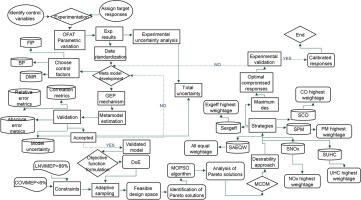Energy Conversion and Management ( IF 9.9 ) Pub Date : 2021-10-01 , DOI: 10.1016/j.enconman.2021.114727 Dipankar Kakati 1 , Srijit Biswas 1 , Rahul Banerjee 1

|
The present study undertakes a comprehensive effort to explore the exergy efficiency-emissions-stability-combustion quality characteristics of premixed methanol with diesel reactivity controlled operation. The combustion phasing of the dual fuel operation primarily depends on the methanol participation rate, wherein the peak in-cylinder pressure and heat release rate decreases with increased methanol injection duration. Though simultaneous reductions of NOx and soot were observed in this study, the stability of the operations deteriorates along with unburned hydrocarbon (UHC) and carbon monoxide (CO) with increasing methanol participations resulting in a trade-off situation. Besides, the severe instability of the operation at 50% load causes misfire due to excessive dilution of the charge at higher methanol participation. The study further explores the potential of Gene Expression Programming assisted meta-model coupled Multi-objective Particle Swarm optimization (MOPSO) algorithm based multi-objective optimization endeavour to explore the optimal operational design space considering the multiple responses of exergy efficiency, NOx, PM, UHC, CO, Coefficient of Variance of indicated mean effective pressure (COVIMEP), lowest normalized value (LNV) of indicated mean effective pressure. In this present case of study, the optimization endeavor has yielded 350 numbers of Pareto solutions, while only 26 numbers of Pareto solutions were observed in the experimental counterpart. Moreover, the experimental domain of the present study has produced only single set of experiment which can satisfy the respective emission limits of NHC and PM altogether, whereas 13 sets were evident in the optimization study to maintain the NHC and PM footprint under the emission constraints simultaneously. The overall analysis of the Pareto solutions evolved in the optimization study has revealed that to attain the minimum NHC and PM footprints, the penalty of exergy efficiency and CO emissions must be incurred. The overall minimum of NHC footprint in the optimization study was recorded as 4.19 g/kWhr, compared to 6.58 g/kWhr as observed in the experimental endeavor. Similarly, the footprint of minimum PM was discovered as 0.13 g/kWhr in the optimization regime, which was 27% lower than the experimental counterpart. However, an imperceptible penalty of 1% was incurred in exergy efficiency, despite of significant lowering of overall minimum CO emissions by 84% in the optimization endeavor compared to the experimental counterpart.
中文翻译:

人工智能辅助 MOPSO 策略,通过 GA 耦合多属性决策方法识别甲醇诱导的 RCCI 努力的火用效率潜力
本研究对柴油反应性控制操作的预混甲醇的火用效率-排放-稳定性-燃烧质量特性进行了全面的探索。双燃料运行的燃烧阶段主要取决于甲醇参与率,其中峰值缸内压力和放热率随着甲醇喷射持续时间的增加而降低。尽管在本研究中观察到 NOx 和烟尘同时减少,但操作的稳定性随着未燃碳氢化合物 (UHC) 和一氧化碳 (CO) 的增加而恶化,甲醇参与度增加,导致权衡情况。此外,在 50% 负载下运行的严重不稳定性会导致由于甲醇参与度较高时装料过度稀释而导致失火。元模型耦合基于多目标粒子群优化 (MOPSO) 算法的多目标优化努力探索考虑火用效率、NOx、PM、UHC、CO、指示平均有效方差系数的多重响应的最佳操作设计空间压力(COV IMEP),指示平均有效压力的最低归一化值 (LNV)。在本研究案例中,优化工作产生了 350 个帕累托解,而在实验对应物中仅观察到 26 个帕累托解。此外,本研究的实验领域仅产生了一组可以同时满足 NHC 和 PM 各自排放限值的实验,而在优化研究中明显有 13 组同时在排放约束下保持 NHC 和 PM 足迹. 优化研究中演化出的帕累托解决方案的整体分析表明,要获得最小的 NHC 和 PM 足迹,必须承担火用效率和 CO 排放的损失。优化研究中 NHC 足迹的总体最小值记录为 4.19 克/千瓦时,而实验中观察到的为 6.58 克/千瓦时。同样,在优化方案中发现最小 PM 的足迹为 0.13 g/kWhr,比实验对应物低 27%。然而,尽管与实验对应物相比,在优化努力中总体最小 CO 排放量显着降低了 84%,但火用效率却产生了 1% 的难以察觉的损失。











































 京公网安备 11010802027423号
京公网安备 11010802027423号